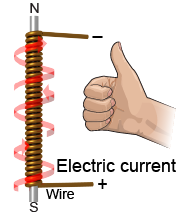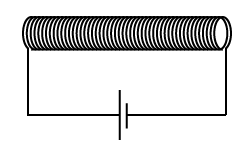|
Although a straight, current-carrying wire does create a magnetic field around it, the field usually isn’t very strong. We could make the magnetic field stronger by passing more current through it, but if we use too much current the wire will overheat and melt! How can we use a current-carrying wire to create a powerful magnetic field? 
|

|
The answer is to use many wires wrapped in a coil (or a series of loops)! When a single piece of wire is bent into a wire loop, the resulting magnetic field everywhere along the curved wire follows the same right-hand rule. In the figure above, all the magnetic field lines point into the top of the wire loop and exit the bottom. When the same wire is wrapped into many coils, the magnetic field produced by each coil is in the same direction—so they add! Any device that uses electric current through multiple loops of wire to create a magnetic field is a solenoid. Many solenoids are created in a cylindrical shape that is significantly longer than the diameter of each wire loop. 
|
Electromagnets are magnets that are created by the flow of electric current. Most electromagnets are created by wrapping the wire coil around a metal core, which increases its strength. The strength also increases by wrapping more coils. You can make a simple electromagnet with wire wrapped around an iron nail and connected to a battery. 
|
 The orientation of the north and south poles of the electromagnet—also called its polarity—depends on the direction of the current in the wire. If the direction of current flow is switched, the polarity of the electromagnet is also switched and the north and south poles reverse. The right-hand rule is used to determine the polarity of the magnetic field. When you wrap your fingers around the wire in the direction the current flows (from the positive to the negative terminal of the battery), your thumb points in the direction of magnetic north.
The orientation of the north and south poles of the electromagnet—also called its polarity—depends on the direction of the current in the wire. If the direction of current flow is switched, the polarity of the electromagnet is also switched and the north and south poles reverse. The right-hand rule is used to determine the polarity of the magnetic field. When you wrap your fingers around the wire in the direction the current flows (from the positive to the negative terminal of the battery), your thumb points in the direction of magnetic north. 
|
The strength of an electromagnet can be controlled by the amount of current that flows in the coil. Using electronic devices, engineers can control the amount and the direction of current and are so able to design electromagnets for all types of applications from security systems to motors. A powerful electromagnet is used by cranes in junkyards to pick up and move heavy metal objects. 
|
 A solenoid is connected to a battery in the illustration at right. In which direction is the north magnetic pole for the resulting magnetic field close to either end of the solenoid: toward the right, left, top, or bottom of the figure?
A solenoid is connected to a battery in the illustration at right. In which direction is the north magnetic pole for the resulting magnetic field close to either end of the solenoid: toward the right, left, top, or bottom of the figure?
 |
The north magnetic pole of the magnetic field close to either end of the solenoid is toward the left. The positive terminal of the battery connects to the left-hand side of the solenoid, so current flows through the solenoid from left to right. By using the right-hand rule, the magnetic field can be seen to point to the left. 
|

